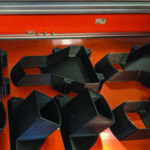Sculpteo recently released it’s State of 3D printing 2017 study. The study is the result of an annual effort at gathering data about the happenings in the B2C and B2B environment of the 3D printing industry. The majority of the respondents for the study were industry professionals. Therefore, the study gives an insight into the professional side, their view of the industry’s needs and their interpretation of the market.
The aim of this article is to provide the key takeaways from the study and analyse their meanings to produce an overview of the industry as it stands today. Another purpose of this article is to elucidate the changes in data as compared to last year.
Sampling
As mentioned earlier, the study was based on questionnaires answered by professionals within the 3D printing industry. There were almost 1000 respondents from 62 different countries. The respondents roles within their companies were also quite diverse. The overall sample was a composite of answers from Engineers (29%), CEOs (28%), Designers (10%) and Freelancers (7%).
The industrial sectors are classified accordingly:
- Consumer Goods (17%)
- Industrial Goods (17%)
- High Tech (13%)
- Services (9%)
- Healthcare sectors (7%)
60% of respondents were between ages 30 – 54, while 24% were 18-29. The gender division in the study was heavily male (92%). While most companies in the sector were making revenue, 27% of companies still had to break that barrier.
Market Outlook
A portion of the report dealt with how these respondents saw the future of 3D printing and how the year went for their respective companies. It also detailed how they view the advantages provided by 3D printing. 90% of all respondents consider 3D printing a competitive advantage. That’s a high number but it is a 3% decrease from the previous year. Readers can interpret this as either a negligible difference or chock it up to a natural result of the wider adoption of 3D printing (making it less of a niche specialty).
77% of respondents in last year’s study said they would boost spending on additive manufacturing technology. However, according to the new data only 49% actually did. Accordingly, 72% expect a rise in spending for the next year and 55% expect a rise in this year. Speaking of costs, a vast majority of respondents believe that declining costs will have the most significant impact on the industry.
47% of the sample saw a greater return on their investment this year. This is compounded by the fact that budgets rose an average of nearly $2,500. Interestingly, when looking at the job market, engineers and designers are most in demand. This potentially means an R and D surge is most likely. This is fitting because R and D is also the department that is most commonly using 3D printers (by 62%).
Materials and Tech
It is unsurprising that plastics have remained the most used materials within the industry. However, one thing that does raise eyebrows is that plastics have risen by 15% from last year. The rise in the use of plastics also coincides with a rise in FDM printing. This year, FDM beat SLS, which this same study had touted as the “undeniable favorite” a year ago.
This can probably be attributed to an increase in the industrial applications of FDM. Considering that SLA often means smaller and more fragile prints. Another reason might be that the most dominant use of 3D printing is in prototyping (34%), proof of concept (23%) and art (8%). All of these usually require FDM. SLM, CLIP and Fusion Jet are newcomers into the category.
Company’s Priorities
Most materials have seen a rise in usage except ceramics and the “other” category. While there is an increase across most of the board, it is exorbitantly higher for plastics. This is good for the whole industry as it means there is a range of applications opening up. It is indicative of growth and innovation. Respondents also said that they believe optimisation in the range of materials is crucial.
Overall, the most common purposes of 3D printing have stayed in roughly the same order. Although, art has seen a 6% increase. The core difference in usage is that all of the various categories are closer in percentages than they were last year. This is also indicative of how 3D printing has more diverse purposes and applies across more fields than before.
The company’s top priorities are overwhelmingly centred around accelerating product development and offering customisable products to their clients. These have been a steady bet across both 2016 and 2017. Overall, the industry looks healthy and most of the needs of the businesses seem stable as of now.




